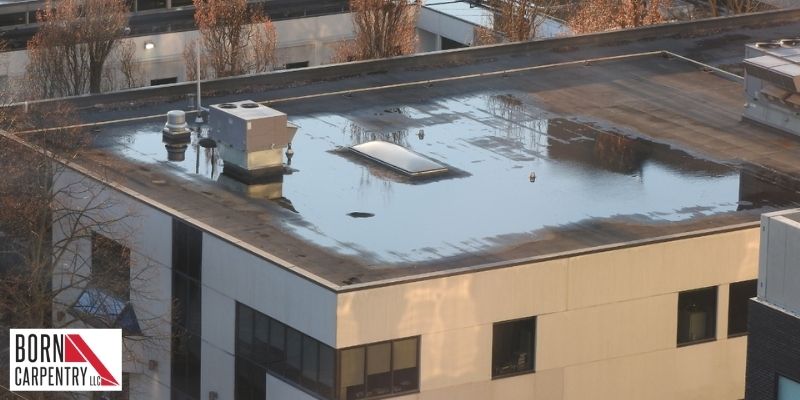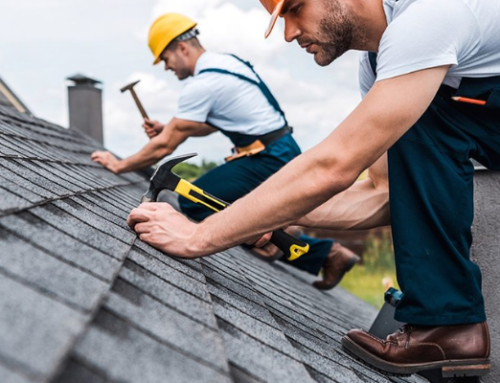Water is one of the few things that can damage equipment and property in a commercial building. It can penetrate the building if the roof is actively leaking. You should be able to identify the cause (and signs) of a roof leak because equipment damaged by water may be expensive to replace or repair.
What Is A Commercial Roof Leak?

A commercial roof is said to be leaking when irrigation, melting snow, or rainwater penetrates a commercial or business building’s roof. Water can pass through the roof when there are even the smallest of holes in your waterproofing membrane. This may lead to further roof damage and other numerous issues, like potential fire, wet insulation, and irreparable damage to equipment.
Signs That A Commercial Roof Is Leaking
Knowing the signs of a commercial roof leak is important in helping you identify and fix the problem before it becomes an even bigger issue. The most common signs of a leaking commercial building include:
Mold and odor
Having a strange odor in your facility is a red flag. It is typically an indicator of mold growth in the ceilings or on the walls. Mold thrives in the presence of rot and moisture. There is a high chance that there is a continuous leak in your commercial roof when you notice a moldy odor in your building.
Dripping water
Water dripping from the ceiling or roof is a sure sign of a commercial roof leak. If you notice puddles on the floor or water droplets and rivulets (small streams) overhead, this is a sign that the leak is quite large. In this case, repair should be done immediately.
Stained ceilings and walls
Roof leaks cause discoloration of ceilings and walls. The color is, in most cases, light brown. This sign can mean that the water damage is extensive. You must find the cause of this issue and address it immediately.
5 Reasons Why Your Commercial Roof Is Leaking
Here are some common causes of a commercial roof leak that you should look out for:
1. Poor drainage

During the installation of a commercial roof, drainage systems should be prioritized. This is required to safely drain off water collected on the rooftop. The drainage should also be done properly to avoid blocking or clogging. A blocked or clogged drain can cause water standing, pooling, or ponding, resulting in roof damage and water leaking into your building.
The drainage of a commercial roof has multiple vulnerable points that include scuppers, downspouts, gutters, and internal drainage pipes. All of these points must be regularly cleaned to ensure that your roof does not get waterlogged. Inspect your drainage for blockages or damage if you notice that water is not properly drained off your roof.
2. Open penetrations
Penetrations like HVAC units, gas lines, vents, pipes, and drainage on the roof cannot be avoided. These items must penetrate the roofing system of your building to function properly. However, they can cause issues that may result in roof leaks. The installation of these items should be done such that there are no unfinished seals or gaps around them that can cause a leak.
3. Damaged roof membrane
The waterproof layer is the membrane of your commercial roof. This membrane prevents snow, irrigation, and rainwater from getting into your building until they drain off. Mechanical issues, foot traffic, falling debris, and heavy winds can damage the membrane. Damage to the membrane can cause constant roof leaks, leading to property damage inside your building.
An affected area can be patched immediately after you notice an anomaly. To avoid damage to the roof membrane, do regular inspections and reduce all foot traffic that is unnecessary on your roof. Keep in mind that pieces of membrane and underlying insulation may need to be replaced when a simple repair will not suffice.
4. Damaged roof flashing
Roof flashings are the metal pieces installed around areas that are in contact with your roof. They are installed in areas around skylights, chimneys, interior walls, and roof edges. When metal flashing is aged or not properly installed, temperature changes and wind can cause damage to it.
Damaged roof flashing can cause leakages in your commercial roof system.
The solution to this issue is straightforward. Investing in new metal flashing is the answer. Make sure a roofing expert does the flashing installation properly.
5. Aging roof
An aging roof is also a common cause of a commercial roof leak. Roofs do not last forever. The waterproof membrane of older roofs degrade when they are constantly exposed to rainwater, melting snow, and other weather elements. Once degradation sets in, water penetration is inevitable in the long run.
Additionally, you must understand that a roof’s lifespan depends on the type of material used, installation quality, maintenance, and some other environmental factors. It’s often more cost-effective to replace an old roof than try and patch it up all the time.
Conclusion
Roofs leak, but you don’t want your commercial building to experience roof leaks, right? If and when you see signs of a leak, have a professional from Born Carpentry fix the leak. You don’t want valuable equipment in the building ruined by water leakage.
If you haven’t had your roof inspected in a long time, and/or you suspect your roof is leaking, call Born Carpentry at 612-747-8003 and schedule a roof inspection.






